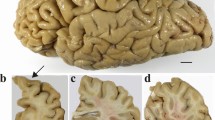A cascade of pathological changes in the intact hemisphere developed in rats 6 months after focal unilateral traumatic brain injury: neuronal degeneration, hyperexpression of α-synuclein, APP (β-amyloid peptide precursor) protein, and glutamine synthetase in cells other than astrocytes. The development of these changes in the contralateral hemisphere indicated the emergence of extensive delayed neurodegenerative processes in the brain after traumatic brain injury, which were characteristic of diseases associated with pathological aging.
Similar content being viewed by others
References
Silachev DN, Uchevatkin AA, Pirogov YA, Zorov DB, Isaev NK. Comparative evaluation of two methods for studies of experimental focal ischemia: magnetic resonance tomography and triphenyltetrazoleum detection of brain injuries. Bull. Exp. Biol. Med. 2009;147(2):269-272.
Davis AE. Mechanisms of traumatic brain injury: biomechanical, structural and cellular considerations. Crit. Care Nurs. Q. 2000;23(3):1-13.
Gardner RC, Yaffe K. Epidemiology of mild traumatic brain injury and neurodegenerative disease. Mol. Cell. Neurosci. 2015;66(Pt B):75-80.
Genrikhs EE, Stelmashook EV, Popova OV, Kapay NA, Korshunova GA, Sumbatyan NV, Skrebitsky VG, Skulachev VP, Isaev NK. Mitochondria-targeted antioxidant SkQT1 decreases trauma-induced neurological deficit in rat and prevents amyloid-β-induced impairment of long-term potentiation in rat hippocampal slices. J. Drug Target. 2015;23(4):347-352.
Gupta R, Sen N. Traumatic brain injury: a risk factor for neurodegenerative diseases. Rev. Neurosci. 2016;27(1):93-100.
Impellizzeri D, Campolo M, Bruschetta G, Crupi R, Cordaro M, Paterniti I, Cuzzocrea S, Esposito E. Traumatic brain injury leads to development of Parkinson’s disease related pathology in mice. Front. Neurosci. 2016;10:458.
Jolkkonen J, Puurunen K, Rantakömi S, Härkönen A, Haapalinna A, Sivenius J. Behavioral effects of the alpha(2)-adrenoceptor antagonist, atipamezole, after focal cerebral ischemia in rats. Eur. J. Pharmacol. 2000;400(2-3):211-219.
Newell KL, Boyer P, Gomez-Tortosa E, Hobbs W, Hedley-Whyte ET, Vonsattel JP, Hyman BT. Alpha-synuclein immunoreactivity is present in axonal swellings in neuroaxonal dystrophy and acute traumatic brain injury. J. Neuropathol. Exp. Neurol. 1999;58(12):1263-1268.
Robinson SR. Neuronal expression of glutamine synthetase in Alzheimer’s disease indicates a profound impairment of metabolic interactions with astrocytes. Neurochem. Int. 2000;36(4-5):471-482.
Robinson SR. Changes in the cellular distribution of glutamine synthetase in Alzheimer’s disease. J. Neurosci. Res. 2001;66(5):972-980.
Schmued LC, Stowers CC, Scallet AC, Xu L. Fluoro-Jade C results in ultra high resolution and contrast labeling of degenerating neurons. Brain Res. 2005;1035(1):24-31.
Shively S, Scher AI, Perl DP, Diaz-Arrastia R. Dementia resulting from traumatic brain injury: what is the pathology? Arch. Neurol. 2012;69(10):1245-1251.
Stelmashook EV, Genrikhs EE, Novikova SV, Barskov IV, Gudasheva TA, Seredenin SB, Khaspekov LG, Isaev NK. Behavioral effect of dipeptide NGF mimetic GK-2 in an in vivo model of rat traumatic brain injury and its neuroprotective and regenerative properties in vitro. Int. J. Neurosci. 2015;125(5):375-379.
Author information
Authors and Affiliations
Corresponding author
Additional information
Translated from Byulleten’ Eksperimental’noi Biologii i Meditsiny, Vol. 164, No. 8, pp. 241-244, August, 2017
Rights and permissions
About this article
Cite this article
Genrikhs, E.E., Voronkov, D.N., Kapkaeva, M.R. et al. Focal Unilateral Traumatic brain injury Causes Delayed Neurodegenerative Changes in the Brain of Rats. Bull Exp Biol Med 164, 211–213 (2017). https://doi.org/10.1007/s10517-017-3960-2
Received:
Published:
Issue Date:
DOI: https://doi.org/10.1007/s10517-017-3960-2




